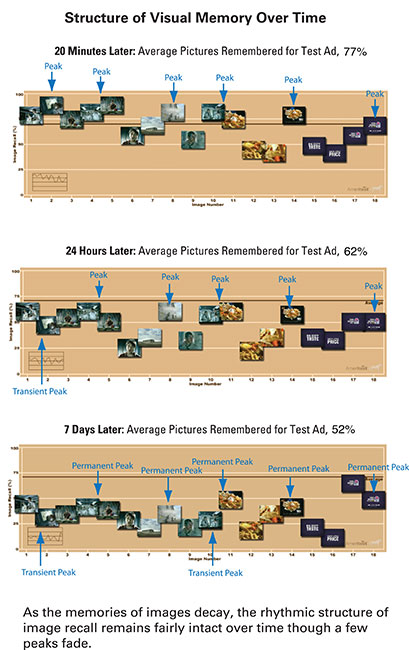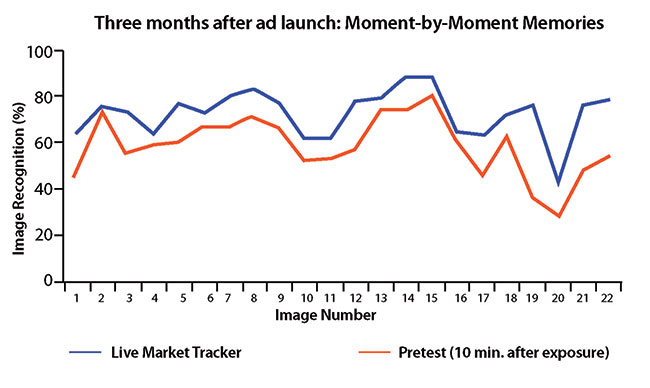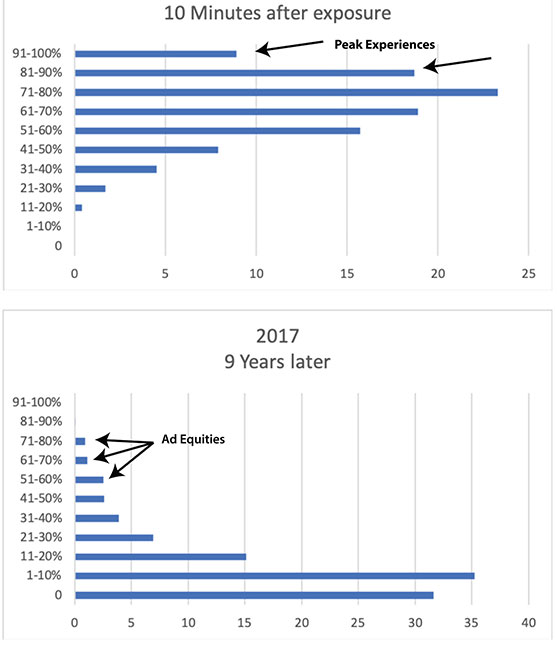Taking up a lot of memory
Editor's note: Charles Young is CEO of Ameritest, an Albuquerque, N.M., research firm.
 Digital has changed many things in advertising. The biggest one for ad researchers? Real-time campaign feedback. But there is growing concern among marketers that this focus on short-term results comes at the expense of creative quality and brand-building.
Digital has changed many things in advertising. The biggest one for ad researchers? Real-time campaign feedback. But there is growing concern among marketers that this focus on short-term results comes at the expense of creative quality and brand-building.
A generation ago, advertising researchers, such as John Philip Jones and Jan Slater, authors of What’s in a Name?, demonstrated that, at least for TV, if there is no short-term sales effect, then there will be no long-term sales effects either. However, the converse is not true – even if there is a short-term sales lift, that does not mean there will be long-term sales contributions. Effective brand-building advertising should do both.
The key is advertising quality – in particular, how sticky the advertising is in consumer memory. After all, brands are not physical entities; they exist only in the minds of customers – brands are structured memories. Like the board game Risk, the goal of the marketer is to colonize more memory space in the mind of the consumer for their product category than their competitors do. Marketing is a game of memory.
Encoding of experience
As a simple model, we can think of human memory as organized much like computer memory in that both include a scheme for the hierarchical encoding of experience. There are similar levels of the memory hierarchy used in designing computer architecture. At the top is the memory register, which is a very small amount of very fast memory necessary for the central processing unit (CPU) to manipulate data. This is the computer analog of the conscious mind. At the next level is cache memory, or locations where frequently requested information is stored for high-speed access. This is the analog of working memory. Below cache is the level of main memory, or random-access memory (RAM). This is the memory system that has been organized according to categories or lists of meanings so that it is searchable in multiple ways.
The hard drive is next. This is where the gigabytes of pictures taken on your smartphone are stored. The bottom levels of the computer architecture analogy represent slow-to-access memories that are stored in various forms off-site. These days that’s the cloud.
Switching to human memory, at the top is the level of consciousness. Here the memory space is small. The original seven-digit length of a telephone number, as Bell Labs found, was the limit that an average person can easily hold in conscious memory. Or the length of a six-second Facebook ad.
The second level is working memory. Working memory deconstructs experience and transfers it into long-term memory. It’s shorter than most people think, lasting only about 30 seconds or the length of a typical brand story ad.
Third is the deeper level of memories that you can recall with some effort. These are memories that have been properly categorized and organized according to meaning in semantic memory. Words are used to tag the meaning of those memories so that they can easily be called forth, like the tags for YouTube videos.
Fourth is the deeper level of memories of past experiences that you cannot recall spontaneously but that you can recognize if given a cue. This is the difference between recognizing the face of someone you’ve met before but whose name you’ve forgotten. These are memories that can only be retrieved by showing people a piece of the original experience, like a picture or the taste of Proust’s petite madeleine.
Most of the non-verbal memories that accumulate in our action-memory system (procedural memory) and our social-memory system (episodic memory) – especially from our pre-adult years – have not been organized and tagged with verbal meanings. Memories that cannot be recalled on demand is what the unconscious mind is.
Fifth are memories stored off-site, in the heads of other people. These are not just memories of the “Honey, have you seen my keys?” variety. Most of the memories that we need to live and do business in the world are found in the heads of the others we interact with, such as butchers, bakers, doctors, lawyers, teachers, priests, etc. Tradition, knowledge and culture operate at this level of memory.
Mental shortlist
In business terms, a hierarchical approach can also be used to manage a brand in memory. The most important measure of brand strength is top-of-mind brand awareness. By top-of-mind, I mean the first brand that is mentioned spontaneously by the consumer when given a category cue. Unaided awareness is derived from all the other brands that are mentioned and form the consumer’s brand consideration set. Together, these are the brands that are on the shopper’s mental shortlist.
As a percentage, either top-of-mind or unaided awareness can be used to measure a brand’s share-of-memory in the category and is the single best predictor of share-of-market. The category leader usually has the strongest top-of-mind awareness, aka brand “salience.”
Below that are the brands consumers can recognize from a list – aided brand awareness. Aided brand awareness is a key measure for new products and niche brands.
Memories that have been tagged with word-meanings can be retrieved through verbal recall. These are memories stored in the semantic memory system and much of the content is rational – the product concept, features and benefits, reasons to believe, etc. All of these memories speak to the brand’s positioning vis-à-vis competitors. But at an even deeper, emotional level lie memories of brand experiences that the brand user can recognize with a visual cue but cannot recall verbally.
Collectively, these are the memories that make up the brand image. Below that are brand memories stored off-site – tribal memories stored in other brains that can be accessed through word-of-mouth and product reviews. This is the basis of shared memories, which are the key to building a brand community.
Arts of persuasion
If I were to pick just one metric from consumer research as a measure of current brand strength, it would be top-of-mind awareness. Any salesperson will tell you that the key to making a sale is to first get on the customers’ shortlist and then to move them to the top of the list through the rational and emotional arts of persuasion.
As a report-card metric, it is fast-moving – reflecting the complex dynamics of the marketplace. It is the leading indicator that moves up first when an established brand is doing well and also moves down first when the brand is doing poorly.
The fact is, top-of-mind awareness is strongly correlated with future purchase intent across most product categories. The main drivers of top-of-mind brand awareness are behavioral – brand last purchased – and advertising. (It is a circular relationship, of course.)
Ad awareness is a function of two variables. First, how much money is spent with various media platforms to reach a target audience. Second, the creative quality of the advertising itself. Of the two, quality is more important. Study after study, including a major one from Nielsen this last year, has once again shown that creative quality is the main driver of advertising ROI.
A few years back we built and published a sales model, using just our own data from testing over 2,000 TV commercials in the fast-food category to explain monthly growth in same-store sales over 77 months for McDonald’s. We found that creative quality explained about 45% of sales growth – a number similar to what Nielsen found. The main variable in the model found that the momentum variable for advertising in the fast-food category lasted about three months after a typical ad went off air.
Will it be remembered?
When determining creative quality, two of the most important questions an advertiser should ask are: Will the ad get noticed and capture audience attention? And, will it be remembered? These two factors are strongly related.
When we test an ad, we deconstruct it frame by frame and use a simple online Picture Sort technique to identify both the moments in the ad that did the best job of capturing audience attention and which images are the stickiest in memory. This data is usually collected about 10 minutes after ad exposure and can be collected on a smartphone.
The memory map (aka “flow of attention”) of an ad video looks like a musical score, with pictures plotted on the staff instead of notes. The height of the pictures on these graphs represents how memorable each image is.

As you can see in Figure 1, after just a very short time, the working memory system has already sorted the images from a test ad into a hierarchy of importance. The graph shows the results of a simple experiment (replicated five times) where matched samples of consumers were shown the same ad 20 minutes after ad exposure, 24 hours after ad exposure and seven days after ad exposure.
As expected, the average recognition level for the set of images in the ad decays over time, from 77% to 62% to 52%. So, about half the images are still remembered a week after seeing the ad.
But the really interesting finding is the similarity of the contour and connectivity of the three memory maps. As the memories of the ad decay, the rhythmic structure of image-level recognition remains fairly intact over time, with peaks remaining peaks and valleys remaining valleys across these different time frames
As an even longer test of memory, we compared the memory map from a pretest, taken 10 minutes after ad exposure, and compared it to the data collected from an in-market tracking study, with an embedded picture-sort question. This data was collected online from the target audience three months after the ad started running live on TV.
As you can see in the graph in Figure 2, the narrative structure of the brand story itself remains intact in memory for a surprisingly long time. The key to driving top-of-mind awareness, and attracting consumer attention, is to create peak, memorable experiences with advertising.

When predicting the attention or engagement scores for an ad, about half the variance in these scores can be explained by a handful of rating statements measuring things like relevant news, entertainment value, relatable situation, etc. The other half can be explained by looking at how the audience filters the visual information in an ad and counting the number of peak experiences created by the ad.
The peak images in an ad, rising to the top of consumer memory afterward, are the buoyant images in an ad and are the ones most likely to push consumer thoughts up from the dark depths of memory into the light of consciousness.
Peaks can contain both new information and emotionally charged images from a brand. Peaks also contain familiar content that has been used in prior advertising, i.e., advertising equities, which are attachment points for attaching new memories to old ones.
In fact, strong new content peaks, packed with emotion and relevant information, are prime candidates to become fresh equities for future advertising if used again in new campaigns.
Submerged structure of brand memories
If top-of-mind awareness of the brand is the part of the proverbial iceberg that sticks above the water, then the bottom-up view refers to the submerged structure of brand memories that floats underneath. These are memories that have been aggregated from past experiences the consumer has had with the brand, including memories from prior advertising.
These submerged memories are the backstory for the brand for new advertising and provide clues to consumer motivations to buy the brand.
So, to push our understanding of branded memory to the limit, as an edge case, a couple of years ago we did a very long-term memory study in the fast-food category. In 2009, we had tested 268 TV commercials in the category, across 17 brands. Our question was: How many of the brand memories created in that year can still be found in consumer memory nine years later?
We began by looking at 4,050 unbranded images that used to measure the memorability of each image 10 minutes after each respondent first saw the ad. Then we retested these same images nine years later, among an additional 5,000 demographically matched category users, to find out which images were still remembered so many years after the advertising ran.
The graphs in Figure 3 show the distribution of how well consumers remember these images at these two points in time. The data from this study confirm that the memory effects of advertising can be quite long lasting. Nine years after exposure, the average recognition level was 12.5%, with only 31% of images getting zero remembering.

Ads that were found to be highly motivating at the time they were tested were significantly more likely to be remembered than images from ads with weak motivation scores, with 16.3% of the imagery from the top quartile of motivating ads being remembered, compared to only 8.4% of imagery from the bottom quartile.
Moreover, this research confirms the importance of emotion in brand-building. Imagery found to be highly charged with emotion at the time of testing (self-reported emotions from our Flow of Emotion sort) were also better remembered. For the strongest quartile of emotional imagery, 17.2% of the images were remembered, compared to 7.6% from the weakest quartile.
The key point here is that not only are long-term ad memories plentiful, they are also predictable. The peak memories of an ad, identified only 10 minutes after first exposure, are highly correlated with the memories that can still be found in consumers’ heads many years later.
The several top layers in the bottom half of the graph are the gold – the memorable imagery from past advertising has been transmuted into brand equities that can be leveraged in future advertising executions to build a stronger bridge between the past and the brand’s future.
Finally, brand memories are not distributed evenly across different segments of the media audience. In this age of micro-targeting, it is important to understand the differences in the brand’s equity across different segments in order. You can actually look at the pictures to see the memory equivalent of a brand Instagram feed for each consumer segment.
Measure of winning and losing
In sum, top-of-mind awareness is the top-down view from the executive suite – it gives you a simple weekly or monthly report card measure of winning and losing in the battle for the consumer’s mind. And at the bottom of memory is the view from the solid ground on which brands can build future growth. All of which tells us that those of us who play the long game of advertising are, at the end of the day, memory makers.
